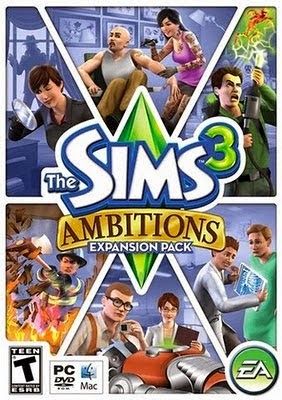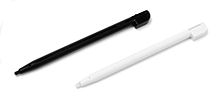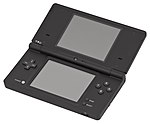

Nintendo DS
 | |
 A blue original Nintendo DS | |
| Also known as | iQue DS (China) |
|---|---|
| Developer | Nintendo |
| Manufacturer | Foxconn |
| Product family | Nintendo DS family |
| Type | Handheld game console |
| Generation | Seventh generation |
| Release date |
|
| Lifespan | 2004–2013 |
| Introductory price | US$149.99[1] |
| Discontinued | 2013[2] |
| Units sold | 154.02 million worldwide (as of June 30, 2016[update])[3] (details) |
| Media | Nintendo game card, ROM cartridge |
| CPU | Two ARM architecture processors |
| Memory | 4 MB RAM |
| Storage | Cartridge save 256 KB flash memory |
| Display | Two TFT LCD, 256 × 192 pixels |
| Connectivity | Wi-Fi (802.11b, WEP) |
| Online services | Nintendo Wi-Fi Connection |
| Best-selling game | New Super Mario Bros., 30.80 million(as of September 30, 2016[update])[4] |
| Backward compatibility | Game Boy Advance |
| Predecessor | Game Boy Advance |
| Successor | Nintendo 3DS |
The Nintendo DS[a], or simply DS, is a line of handheld game console produced by Nintendo. The device released globally across 2004 and 2005. The DS, an initialism for "Developers' System" or "Dual Screen",[5] introduced distinctive new features to handheld gaming: two LCD screens working in tandem (the bottom one being a touchscreen), a built-in microphone and support for wireless connectivity.[6] Both screens are encompassed within a clamshell design similar to the Game Boy Advance SP. The Nintendo DS also features the ability for multiple DS consoles to directly interact with each other over Wi-Fi within a short range without the need to connect to an existing wireless network. Alternatively, they could interact online using the now-defunct Nintendo Wi-Fi Connection service. Its main competitor was Sony's PlayStation Portable during the seventh generation of video game consoles.
Prior to its release, the Nintendo DS was marketed as an experimental "third pillar" in Nintendo's console lineup, meant to complement the Game Boy Advance and GameCube. However, backward compatibility with Game Boy Advance titles and strong sales ultimately established it as the successor to the Game Boy series.[7] On March 2, 2006, Nintendo launched the Nintendo DS Lite, a slimmer and lighter redesign of the original Nintendo DS with brighter screens. On November 1, 2008, Nintendo released the Nintendo DSi, another redesign with several hardware improvements and new features, although it lost backwards compatibility for Game Boy Advance titles and a few original DS games that used the GBA slot. All Nintendo DS models combined have sold 154.02 million units,[8] making it the best selling handheld game console to date, and the second best selling video game console of all time behind Sony's PlayStation 2.[3][9] The Nintendo DS line was succeeded by the Nintendo 3DS family in 2011, which maintains backward compatibility with nearly all Nintendo DS software except for some software that requires the GBA slot for use.
History[edit]
Development[edit]
Development on the Nintendo DS began around mid-2002, following an original idea from former Nintendo president Hiroshi Yamauchi about a dual-screened console.[10] On November 13, 2003, Nintendo announced that it would be releasing a new game product in 2004. The company did not provide many details, but stated it would not succeed the Game Boy Advance or GameCube.[11] On January 20, 2004, the console was announced under the codename "Nintendo DS".[12] Nintendo released only a few details at that time, saying that the console would have two separate, 3-inch TFT LCD display panels, separate processors, and up to 1 gigabit (128 Megabytes) of semiconductor memory.[12][13] Current Nintendo president at the time, Satoru Iwata, said, "We have developed Nintendo DS based upon a completely different concept from existing game devices in order to provide players with a unique entertainment experience for the 21st century."[12] He also expressed optimism that the DS would help put Nintendo back at the forefront of innovation and move away from the conservative image that has been described about the company in years past.[14] In March 2004, a document containing most of the console's technical specifications was leaked, also revealing its internal development name, "Nitro".[15] In May 2004, the console was shown in prototype form at E3 2004, still under the name "Nintendo DS".[16] On July 28, 2004, Nintendo revealed a new design that was described as "sleeker and more elegant" than the one shown at E3 and announced Nintendo DS as the device's official name.[17] Following lukewarm GameCube sales, Hiroshi Yamauchi stressed the importance of its success to the company's future, making a statement which can be translated from Japanese as, "If the DS succeeds, we will rise to heaven, but if it fails we will sink to hell."[18][19]
Launch[edit]
President Iwata referred to Nintendo DS as "Nintendo's first hardware launch in support of the basic strategy 'Gaming Population Expansion'" because the touch-based device "allows users to play intuitively".[20] On September 20, 2004, Nintendo announced that the Nintendo DS would be released in North America on November 21, 2004 for US$149.99.[21] It was set to release on December 2, 2004 in Japan (¥15000);[22] on February 24, 2005 in Australia ($199.95);[23] and on March 11, 2005 in Europe (£99.99/€149.99).[24] The console was released in North America with a midnight launch event at Universal CityWalk EB Games in Los Angeles, California. The console was launched quietly in Japan compared to the North America launch; one source cites the cold weather as the reason.[25] Regarding the European launch, Nintendo President Satoru Iwata said this:
"Europe is an extremely important market for Nintendo, and we are pleased we can offer such a short period of time between the US and European launch. We believe that the Nintendo DS will change the way people play video games and our mission remains to expand the game play experience. Nintendo DS caters for the needs of all gamers whether for more dedicated gamers who want the real challenge they expect, or the more casual gamers who want quick, pick up and play fun".[26]
North America and Japan[edit]
The Nintendo DS was launched in North America for US$149.99 on November 21, 2004; in Japan for JP¥15,000 on December 2 in the color "Titanium". Well over three million preorders were taken in North America and Japan; preorders at online stores were launched on November 3, and ended the same day as merchants had already sold their allotment. Initially Nintendo planned to deliver one million units combined at the North American and Japanese launches; when it saw the preorder numbers, it brought another factory online to ramp up production. Nintendo originally slated 300,000 units for the U.S. debut; 550,000 were shipped, and just over 500,000 of those sold through in the first week. Later in 2005, the manufacturer suggested retail price for the Nintendo DS was dropped to US$129.99.
Both launches proved to be successful, but Nintendo chose to release the DS in North America prior to Japan, a first for a hardware launch from the Kyoto-based company. This choice was made to get the DS out for the largest shopping day of the year in the U.S. (the day after Thanksgiving, also known as "Black Friday").[27] Perhaps partly due to the release date, the DS met unexpectedly high demand in the United States, selling 1 million units by December 21, 2004. By the end of December, the total number shipped worldwide was 2.8 million, about 800,000 more than Nintendo's original forecast.[28] At least 1.2 million of them were sold in the U.S. Some industry reporters referred to it as "the Tickle Me Elmo of 2004".[29] In June 2005, Nintendo informed the press that a total of 6.65 million units had been sold worldwide.[30]

As is normal for electronics, some were reported as having problems with stuck pixels in either of the two screens. Return policies for LCD displays vary between manufacturers and regions, however in North America, Nintendo has chosen to replace a system with fixed pixels only if the owner claims that it interferes with their gaming experience. There were two exchange programs in place for North America. In the first, the owner of the defective DS in question would provide a valid credit card number and, afterwards, Nintendo would ship a new DS system to the owner with shipping supplies to return the defective system. In the second, the owner of the defective DS in question would have shipped their system to Nintendo for inspection. After inspection, Nintendo technicians would have either shipped a replacement system or fixed the defective system. The first option allowed the owner to have a new DS in 3–5 business days.
Multiple games were released alongside the DS during its North American launch on November 21, 2004. At launch there was one pack-in demo, in addition to the built-in PictoChat program: Metroid Prime Hunters: First Hunt (published by Nintendo and is a demo for Metroid Prime Hunters, a game released in March 2006). At the time of the "Electric Blue" DS launch in June 2005, Nintendo bundled the system with Super Mario 64 DS.
In Japan, the games were released at the same time as the system's first release (December 2, 2004). In the launch period, The Prince of Tennis 2005 -Crystal Drive- (Konami) and Puyo Puyo Fever (Puyo Pop Fever) (Sega) were released.
Europe[edit]
The DS was released in Europe on March 11, 2005 for €149. A small supply of units were available prior to this in a package with a promotional "VIP" T-shirt, Metroid Prime Hunters - First Hunt, a WarioWare: Touched! demo, and a pre-release version of Super Mario 64 DS, through the Nintendo Stars Catalogue; the bundle was priced at £129.99 for the UK and €189.99 for the rest of Europe, plus 1,000 of Nintendo's "star" loyalty points (to cover postage). As of 23 January 2006[update], 1 million DS units had been sold in Europe, setting a sales record for a handheld console.
The European release of the DS, like the U.S., was originally packaged with a Metroid Prime Hunters: First Hunt demo. The European packaging for the console is noticeably more "aggressive" than that of the U.S./Japanese release.[clarification needed][citation needed] The European game cases are additionally about 1/4 inch thicker than their North American counterparts and transparent rather than solid black. Inside the case there is room for one Game Boy Advance game pak and a DS card with the instructions on the left side of the case.
Australia and New Zealand[edit]
The DS launched in Australia and New Zealand on February 24, 2005. It retailed in Australia for AU$199 and in New Zealand for NZ$249. Like the North American launch, it includes the Metroid Prime Hunters - First Hunt demo. The first week of sales for the system broke Australian launch sales records for a console, with 19,191 units sold by the 27th.
China[edit]
"iQue DS", the official name of the Chinese Nintendo DS, was released in China on July 23, 2005. The price of the iQue DS was 980 RMB (roughly US$130) as of April 2006. This version of the DS includes updated firmware to block out use of the PassMe device, along with the new Red DS. Chinese launch games were Zhi Gan Yi Bi (Polarium) (Nintendo/iQue) and Momo Waliou Zhizao (WarioWare: Touched!) (Nintendo/iQue). The iQue was also the name of the device that China received instead of the Nintendo 64.
Games available on launch[edit]
Promotion[edit]
The system's promotional slogans revolve around the word "Touch" in almost all countries, with the North American slogan being "Touching is good."[31]
The Nintendo DS was seen by many analysts to be in the same market as Sony's PlayStation Portable, although representatives from both companies have said that each system targets a different audience.[citation needed]Time magazine awarded the DS a Gadget of the Week award.[32]
At the time of its release in the United States, the Nintendo DS retailed for US$149.99. The price dropped to US$129.99 on August 21, 2005, one day before the releases of Nintendogs and Advance Wars: Dual Strike.
Nine official colors of the Nintendo DS were available through standard retailers. Titanium-colored units were available worldwide, Electric Blue was exclusive to North and Latin America. There was also a red version which was bundled with the game Mario Kart DS. Graphite Black, Pure White, Turquoise Blue, and Candy Pink were available in Japan. Mystic Pink and Cosmic Blue were available in Australia and New Zealand. Japan's Candy Pink and Australia's Cosmic Blue were also available in Europe and North America through a Nintendogs bundle, although the colors are just referred to as pink and blue; however, these colors were available only for the original style Nintendo DS; a different and more-limited set of colors were used for the Nintendo DS Lite.
Sales[edit]
As of March 31, 2016, all Nintendo DS models combined have sold 154.02 million units, making it the best selling handheld game console to date, and the second best selling video game console of all time.[3][33]
Legacy[edit]
The success of the DS paved the way for its successor, the Nintendo 3DS, a handheld gaming console with a similar dual-screen setup which can display images on the top screen in stereoscopic 3D.[34]
On January 29, 2014, Nintendo announced that Nintendo DS games would be added to the Wii U Virtual Console, with the first game, Brain Age: Train Your Brain in Minutes a Day!, being released in Japan on June 3, 2014.[35][36]
Hardware[edit]

The Nintendo DS[37] design resembles that of the multi-screen games from the Game & Watch line, such as Donkey Kong and Zelda, which was also made by Nintendo.
The lower display of the Nintendo DS is overlaid with a resistive touchscreen designed to accept input from the included stylus, the user's fingers, or a curved plastic tab attached to the optional wrist strap. The touchscreen lets users interact with in-game elements more directly than by pressing buttons; for example, in the included chatting software, PictoChat, the stylus is used to write messages or draw.
The handheld features four lettered buttons (X, Y, A, B), a directional pad, and Start, Select, and Power buttons. On the top of the device are two shoulder buttons, a game card slot, a stylus holder and a power cable input. The bottom features the Game Boy Advance game card slot. The overall button layout resembles that of the Super Nintendo Entertainment System controller. When using backward compatibility mode on the DS, buttons X and Y and the touchscreen are not used as the Game Boy Advance line of systems do not feature these controls.
It also has stereo speakers providing virtual surround sound (depending on the software) located on either side of the upper display screen. This was a first for a Nintendo handheld, as the Game Boy line of systems had only supported stereo sound through the use of headphones or external speakers. A built-in microphone is located below the left side of the bottom screen. It has been used for a variety of purposes, including speech recognition, chatting online between and during gameplay sessions, and minigames that require the player to blow or shout into it.
Models[edit]
Nintendo DS Lite[edit]
The Nintendo DS Lite[b] is the first redesign of the Nintendo DS. While retaining the original model's basic characteristics, it features a sleeker appearance, larger stylus, longer lasting battery and brighter screens.[38] Nintendo considered a larger model of the Nintendo DS Lite for release, but decided against it as sales of the original redesign were still strong. It was the final DS to have backwards compatibility with Game Boy Advance games.[39] As of March 31, 2014, shipments of the DS Lite had reached 93.86 million units worldwide, according to Nintendo.[3]
Nintendo DSi[edit]

The Nintendo DSi[c] is the second redesign of the Nintendo DS. It is based on the unreleased larger Nintendo DS Lite model. While similar to the previous DS redesign, new features include two inner and outer 0.3 megapixel digital cameras, a larger 3.25 inch display, internal and external content storage, compatibility with WPA wireless encryption, and connectivity to the Nintendo DSi Shop.

-
-